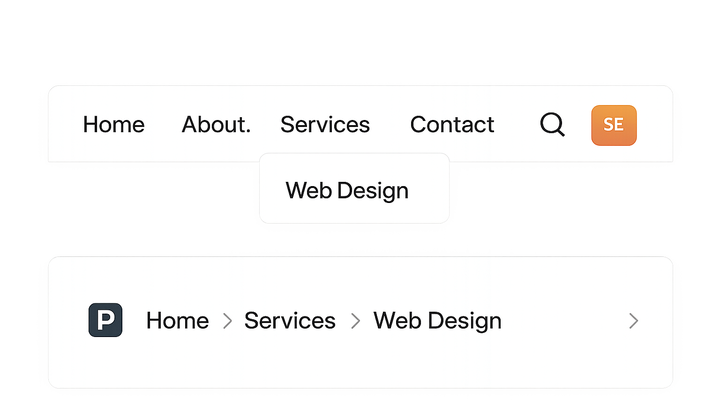Published on 2025-06-29T20:26:12Z
What is Navigation? Examples of Navigation.
Navigation refers to the system of menus, links, breadcrumbs, and search bars that guide users and search engines through a website’s content.
Effective navigation:
- Improves user satisfaction by making it easy to find information.
- Boosts conversion rates by steering visitors toward desired actions.
- Enhances SEO by creating clear pathways for crawlers.
Poor navigation leads to frustration, higher bounce rates, and missed lead-generation opportunities. In CRO, highlighting priority CTAs within navigation reduces friction. From an SEO standpoint, logical structures distribute link equity and improve crawlability. UX research shows intuitive navigation lowers cognitive load and supports accessibility. Tools like Prevue.me can audit navigation by offering actionable critiques on hierarchy, labeling, mobile usability, and accessibility.
Navigation
The system of menus, links, and tools that guide users and search engines through a site, critical for UX, SEO, and CRO.
Definition and Importance of Navigation
Navigation is the blueprint of a website that dictates how users and search engines find and access content. It establishes the hierarchy of pages and determines the ease with which visitors can locate information, enhancing overall user satisfaction and driving conversions.
-
Definition
The system of menus, links, and search features that connect different areas of a website and guide user journeys.
-
Why it matters for users
Intuitive navigation reduces cognitive load, boosts engagement, and ensures visitors find what they need quickly, lowering bounce rates.
-
Why it matters for seo and cro
Clear navigation distributes link equity, improves crawlability, and directs users toward high-value pages and calls to action, increasing conversion potential.
Key Types of Website Navigation
Different navigation elements serve unique roles. A balanced mix ensures users can move through the site efficiently.
-
Main navigation
Primary menu usually found in the header, linking to top-level pages and key sections.
-
Secondary navigation
Supplementary links often seen in sidebars or submenus, helping users delve deeper into specific topics.
-
Footer navigation
Links placed at the bottom of pages for legal info, contact, and less-prominent but essential pages.
-
Breadcrumbs
Trail showing the user’s path within the site hierarchy, aiding orientation and backtracking.
-
Search navigation
Site-wide search function allowing users to input queries and quickly locate content.
Best Practices for Effective Navigation
Implementing proven guidelines helps create navigation that works seamlessly across devices and user expectations.
-
Clear, descriptive labels
Use concise and familiar terms for menu items so users immediately understand their destination.
-
Logical hierarchy
Structure menus in a shallow hierarchy, ensuring important pages are no more than two clicks away from the homepage.
-
Mobile responsiveness
Ensure navigation adapts to smaller screens with collapsible menus or hamburger icons for a smooth mobile experience.
-
Accessibility compliance
Include ARIA labels, keyboard navigation, and high-contrast design to accommodate all users, including those with disabilities.
Navigation’s Impact on CRO, UX, and SEO
Navigation elements influence key performance metrics across conversion, user experience, and search optimization.
-
Cro
Guiding visitors to targeted pages and CTAs with minimal friction increases click-through and conversion rates.
-
Ux
A coherent navigation system reduces frustration, improves task completion times, and enhances overall satisfaction.
-
Seo
Site architecture with clear navigation ensures crawlers index pages properly and distributes link authority effectively.
How Prevue.me Critiques and Optimizes Navigation
prevue.me provides automated, actionable feedback across CRO, UX, SEO, and accessibility to refine your site’s navigation.
-
Hierarchy and structure analysis
Evaluates menu depth and page click distance, recommending a more efficient hierarchy for conversions and crawlability.
-
Label clarity feedback
Assesses menu item wording for clarity and SEO relevance, suggesting optimized labels to match user intent and keywords.
-
Mobile usability review
Tests mobile navigation patterns, identifying issues with taps, touch targets, and responsive menus to improve UX.
-
Accessibility assessment
Checks for ARIA attributes, keyboard focus order, and color contrast in navigation elements to meet WCAG standards.
